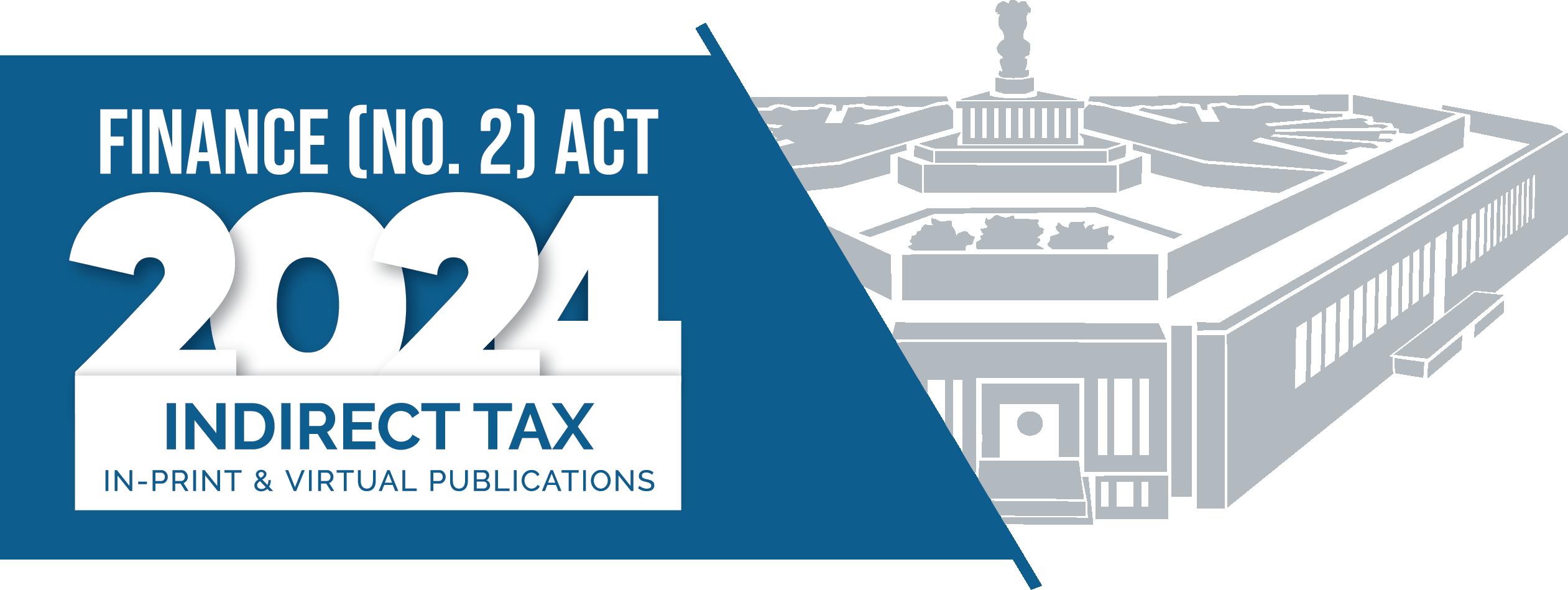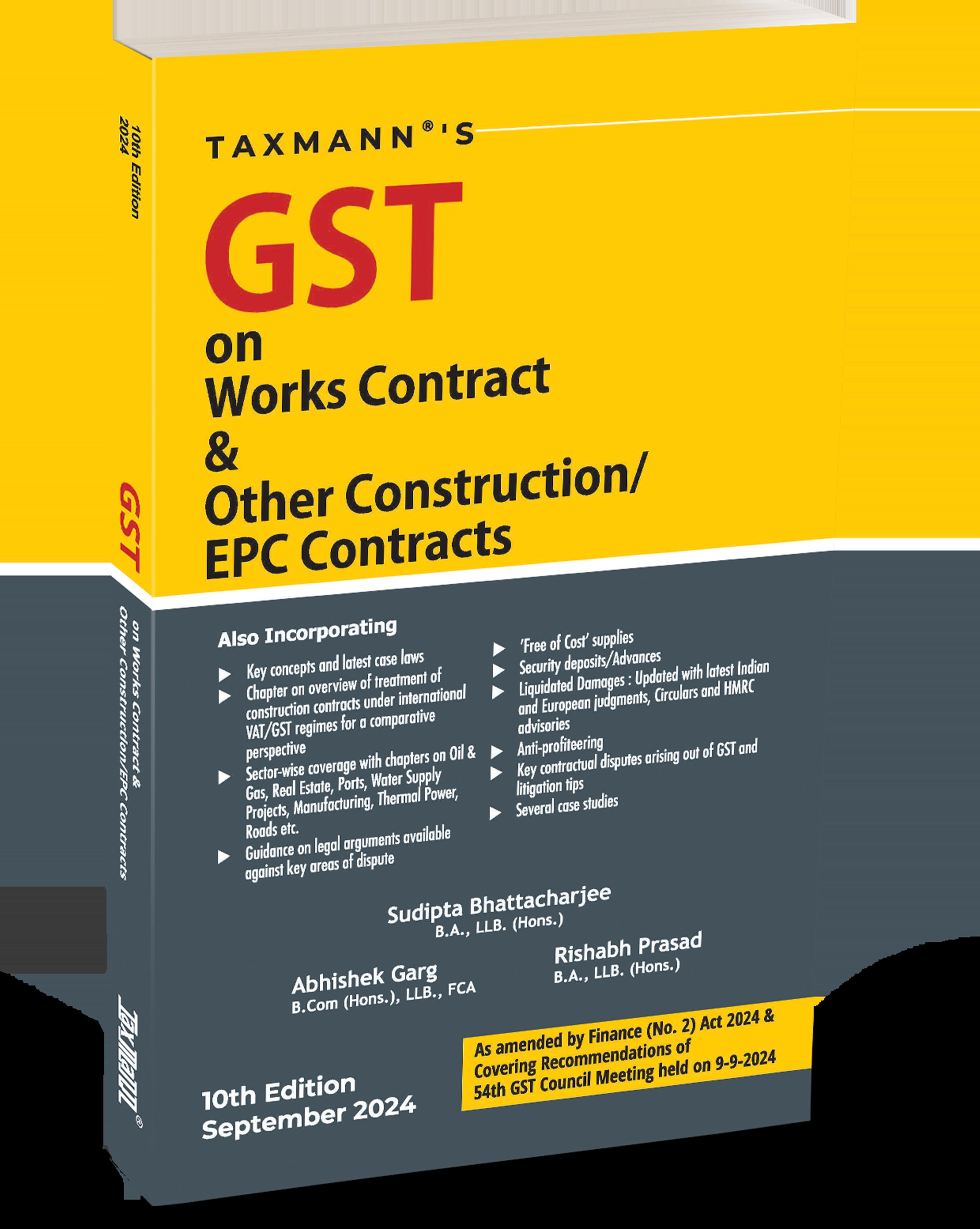About the Authors I-5 Preface to Tenth Edition I-9 Acknowledgement I-11 CHAPTER 1
TO THE SCHEME OF GST 1
2 EVOLUTION OF ‘WORKS CONTRACT’ PRE-GST 10
CHAPTER 3
DEFINITION OF ‘WORKS CONTRACT’ UNDER GST 27
CHAPTER 4
OVERVIEW OF TREATMENT OF CONSTRUCTION CONTRACTS UNDER INTERNATIONAL VAT/GST REGIMES FOR A COMPARATIVE PERSPECTIVE 33
CHAPTER 5
‘WORKS CONTRACT’ MUST PERTAIN TO ‘IMMOVABLE PROPERTY’ - WHAT IS ‘IMMOVABLE PROPERTY’? 38
CHAPTER 6
FOR A CONTRACT TO QUALIFY AS ‘WORKS CONTRACT’, IT MUST INVOLVE ‘TRANSFER OF PROPERTY IN GOODS’WHAT IS ‘TRANSFER OF PROPERTY IN GOODS’? 50
CHAPTER 7
‘COMPOSITE’ AND ‘MIXED’ SUPPLY - RELEVANCE UNDER ‘WORKS CONTRACT’ 53
CHAPTER 8
INTERPLAY BETWEEN COMPOSITE SUPPLY, MIXED SUPPLY AND WORKS CONTRACTS 69
CHAPTER 9
CLASSIFICATION OF SERVICES UNDER GST AND ‘WORKS CONTRACTS’ 78
CHAPTER 10
INPUT TAX CREDIT FOR ‘WORKS CONTRACT’ 83
CHAPTER 11
CASE STUDIES TO PRACTICALLY UNDERSTAND WHETHER A CONTRACT WOULD QUALIFY AS ‘WORKS CONTRACT’
CHAPTER 12
REGISTRATION FOR WORKS CONTRACTOR UNDER GST
CHAPTER 13
TIME OF SUPPLY AND ISSUANCE OF INVOICE (POINT OF TAXATION)
CHAPTER 14
IMPACT OF GST ON ADVANCES/ SECURITY DEPOSITS ETC. 136
CHAPTER 15
VALUATION AND ‘FREE OF COST’ SUPPLIES BY THE CUSTOMER
CHAPTER 16
PLACE OF SUPPLY
CHAPTER 17 LIQUIDATED DAMAGES UNDER WORKS CONTRACTS & GST
CHAPTER 18
GST RATES AS APPLICABLE ON VARIOUS TYPES OF WORKS CONTRACTS
CHAPTER 19
SUMMARIZING THE KEY DIFFERENCES IN ‘WORKS CONTRACT’ IN THE PRE AND POST GST ERA
CHAPTER 20
TRANSITION PROVISIONS UNDER GST FOR WORKS CONTRACT
CHAPTER 21
DEDUCTION AT SOURCE (“TDS”)
CHAPTER 22
WORKS CONTRACT AND IMPLICATIONS IN OIL & GAS SECTOR
CHAPTER 23
WORKS CONTRACT AND IMPLICATIONS IN REAL ESTATE
CHAPTER 24 WORKS CONTRACT AND IMPLICATIONS FOR ROADS/ HIGHWAYS
CHAPTER 25
WORKS CONTRACTS AND IMPLICATIONS ON PORTS
CHAPTER 26
WORKS CONTRACT AND IMPLICATIONS ON THERMAL POWER
CHAPTER 27 WORKS CONTRACT AND IMPLICATIONS ON SOLAR
CHAPTER 28
WORKS CONTRACT AND IMPLICATIONS ON LARGE MANUFACTURING PLANTS
CHAPTER 29
WORKS CONTRACT AND IMPLICATIONS ON LARGE WATER SUPPLY PROJECTS
CHAPTER 30
GST AND ANTI-PROFITEERING
CHAPTER 31
PRACTICAL STRATEGIES VIS-A-VIS STRUCTURING OF VARIOUS TYPES OF WORKS CONTRACT UNDER GST 364
CHAPTER 32
WHAT HAPPENS TO ‘NO-INCOME TAX’ POSITION FOR OFFSHORE SUPPLIES UNDER A SINGLE EPC CONTRACT, POST GST? 375
CHAPTER 33
BEST PRACTICES FOR TAX CONTROVERSY MANAGEMENT UNDER GST 380
ANNEXURES
ANNEXURE 1 - RELEVANT CGST RATE SCHEDULE FOR SERVICES 393
ANNEXURE 2 - MAHARASHTRA GST ACT - NEW COMPOSITION SCHEME FOR BUILDER AND DEVELOPER 403
ANNEXURE 3 - RELEVANT EXPLANATORY NOTES TO THE SCHEME OF CLASSIFICATION OF SERVICES 408
RELEVANCE UNDER ‘WORKS CONTRACT’
GST - Drawing Splits and Bundles from Composite and Mixed
Card Protection Plan Ltd. v. Commissioners of Customs and Excise
Economic Point of view
Single service.
Single Economic Service
Principal Services
Single
Readers would recall that the first draft of the Model GST Law of June, 2016 introduced the concept of ‘composite supply’ to mean two or more goods or services or goods and services which are supplied together in the course or furtherance of business. However, this concept was crystallized by the revised draft of the Model GST Law of November, 2016 wherein the definition of composite supply was completely changed and replaced to mean two or more taxable supplies of goods or services which are naturally bundled in the ordinary course of business. The revised draft also introduced the definition of ‘mixed supply’ to mean two or more individual supplies of goods or services for a single price.
7.1 COMPOSITE SUPPLY
“Supply made by a taxable person to a recipient consisting of two or more taxable supplies of goods or services or both, or any combination thereof, which are naturally bundled and supplied in conjunction with each other in the ordinary course of business, one of which is a principal supply
Illustration Where goods are packed and transported with insurance, the supply of goods, packing materials, transport and insurance is a composite supply and supply of goods is a principal supply”
“Supply of goods or services which constitutes the predominant element of a composite supply and to which any other supply forming part of that composite supply is ancillary. Basis the foregoing, it can be observed that the concept of ‘dominant intention test’ has been granted statutory approval in the GST regime in the context of ‘composite supplies’”
Para 7.1
7.2 GUIDANCE ISSUED BY GST COUNCIL FOR COMPOSITE SUPPLIES54
“A works contract and restaurant services are classic examples of composite supplies, however the GST Act identifies both as supply of services and chargeable to specific rate of tax mentioned against such services (works contract and restaurants).
In respect of composite supplies (other than the two categories mentioned above), the need to determine the supply as a composite one, will arise, so as to determine the appropriate classification. It will be necessary to determine as to whether a particular supply is naturally bundled in the ordinary course of business and what constitutes principal supply in such composite supplies. The concept of composite supply under GST is identical to the concept of naturally bundled services prevailing in the existing service tax regime.
This concept has been explained in the Education Guide issued by CBEC in the year 2012 as under:
“Bundled service means a bundle of provision of various services wherein an element of provision of one service is combined with an element or elements of provision of any other service or services. An example of ‘bundled service’ would be air transport services provided by airlines wherein an element of transportation of passenger by air is combined with an element of provision of catering service on board. Each service involves differential treatment as a manner of determination of value of two services for the purpose of charging service tax is different.”
55 Para 7.2
Sprint R.P.G. India Ltd. Collector of Central Excise
The rule is - ‘If various elements of a bundled service are naturally bundled in the ordinary course of business, it shall be treated as provision of a single service which gives such bundle its essential character.
Illustration :
A hotel provides a 4-D/3-N package with the facility of breakfast. This is a natural bundling of services in the ordinary course of business. The service of hotel accommodation gives the bundle the essential character and would, therefore, be treated as service of providing hotel accommodation.
A 5 star hotel is booked for a conference of 100 delegates on a lump sum package with the following facilities:
Accommodation for the delegates
Breakfast for the delegates
Tea and coffee during conference
Access to fitness room for the delegates
Availability of conference room
Business centre
As is evident, a bouquet of services is being provided, many of them chargeable to different effective rates of tax. None of the individual constituents are able to provide the essential character of the service. However, if the service is described as convention service, it is able to capture the entire essence of the package. Thus, the service may be judged as convention service and chargeable to full rate. However, it will be fully justifiable for the hotel to charge individually for the services as long as there is no attempt to offload the value of one service on to another service that is chargeable at a concessional rate.
Whether the services are bundled in the ordinary course of business, would depend upon the normal or frequent practices followed in the area of business to which services relate. Such normal and frequent practices adopted in a business can be ascertained from several indicators some of which are listed below:
The perception of the consumer or the service receiver - If large number of service receivers of such bundle of services reasonably expect such services to be provided as a package, then such a package could be treated as naturally bundled in the ordinary course of business.
Majority of service providers in a particular area of business provide similar bundle of services. For example, bundle of catering on board and transport by air is a bundle offered by a majority of airlines. Para 7.2
Para 7.3
The nature of the various services in a bundle of services will also help in determining whether the services are bundled in the ordinary course of business. If the nature of services is such that one of the services is the main service and the other services combined with such service are in the nature of incidental or ancillary services which help in better enjoyment of a main service. For example, service of stay in a hotel is often combined with a service or laundering of 3-4 items of clothing free of cost per day. Such service is an ancillary service to the provision of hotel accommodation and the resultant package would be treated as services naturally bundled in the ordinary course of business.
Other illustrative indicators, not determinative but indicative of bundling of services in the ordinary course of business are:—
There is a single price or the customer pays the same amount, no matter how much package they actually receive or use.
The elements are normally advertised as a package.
The different elements are not available separately.
The different elements are integral to one overall supply. If one or more is removed, the nature of the supply would be affected.
No straight jacket formula can be laid down to determine whether a service is naturally bundled in the ordinary course of business. Each case has to be individually examined in the backdrop of several factors some of which are outlined above. The above principles explained in the light of what constitutes a naturally bundled service can be gainfully adopted to determine whether a particular supply constitutes a composite supply under GST and if so what constitutes the principal supply so as to determine the right classification and rate of tax of such composite supply.”
7.3 MIXED SUPPLY
mixed supply
“Two or more individual supplies of goods or services, or any combination thereof, made in conjunction with each other by a taxable person for a single price where such supply does not constitute a composite supply.
Illustration.— A supply of a package consisting of canned foods, sweets, chocolates, cakes, dry fruits, aerated drinks and fruit juices when supplied for a single price is a mixed supply. Each of these items can be supplied separately and is not dependent on any other. It shall not be a mixed supply if these items are supplied separately”
7.4 GUIDANCE ISSUED BY GST COUNCIL FOR MIXED
SUPPLIES55
“In order to identify if the particular supply is a mixed supply, the first requisite is to rule out that the supply is a composite supply. A supply can be a mixed supply only if it is not a composite supply. As a corollary it can be said that if the transaction consists of supplies not naturally bundled in the ordinary course of business then it would be a mixed supply. Once the amenability of the transaction as a composite supply is ruled out, it would be a mixed supply, classified in terms of supply of goods or services attracting highest rate of tax.
The following illustration given in the Education Guide of CBEC referred above can be a pointer towards a mixed supply of services: A house is given on rent one floor of which is to be used as residence and the other for housing a printing press. Such renting for two different purposes is not naturally bundled in the ordinary course of business. Therefore, if a single rent deed is executed it will be treated as a service comprising entirely of such service which attracts highest liability of service tax. In this case, renting for use as residence is a negative list service while renting for non-residence use is chargeable to tax. Since the latter category attracts highest liability of service tax amongst the two services bundled together, the entire bundle would be treated as renting of commercial property”
7.5 CASE STUDY A
A contract is entered between two companies for providing comprehensive annual maintenance for equipment (like printers, photocopying machines etc. which do not qualify as ‘immovable property’). Further, the scope of work includes preventive maintenance visits, supervision, testing, breakdown and shutdown visits as & when required and replacement of faulty spares.
59 Para 7.7
i Industrial practice -
ii Supply of goods/services are concomitant to the other supply-
i.e.
7.6 CASE STUDY B
A Company enters into a Leave and License Agreement with another Company providing for the latter to use and occupy an area and for the same receives monthly charges along with applicable taxes. The Agreement also provides for maintenance services, car parking space, space for signage and erection of equipment, power back-up up to the prescribed limit and water and sewage connections.
In this scenario, services of leave and licensing (i.e. renting of immovable property), being the principal supply shall determine the GST liability.
7.7 KEY ADVANCE RULINGS PRONOUNCED UNDER GST ON ‘COMPOSITE’ AND ‘MIXED’ SUPPLIES
(i) BC Examinations and English Services India Pvt. Ltd. - HAR/ HAAR/R/2017-18/11
Questions Raised:
Held:
(ii) Five Star Shipping - MAH/AAAR/SS-RJ/11/2018-19
Questions Raised
Held -
(iii) Switching Avo Electric Power 2018-VIL-01-AAR
Questions Raised:inter alia -
Held:
Since a single price is charged, it will qualify as a mixed supply built-in batteries
Remarks: vide
supplied in conjunction with each other”
(iv) Sandvik Asia Pvt. Ltd. 2018-VIL-283-AAR
Questions Raised:
Held:
(v) IL&FS Education & Technology Services Limited 2018-VIL-94-AAR
Questions Raised:
Para 7.7
Para 7.7
Modification of the above order by AAAR
i Card Protection Plan supra
ii -
iii KALYAN TOLL INFRASTRUCTURE LTD 2019-VIL-428-AAR
Questions Raised
Held:
GST ON WORKS CONTRACT & OTHER CONSTRUCTION/EPC CONTRACTS
AUTHOR : ABHISHEK GARG, RISHABH PRASAD, SUDIPTA BHATTACHARJEE
PUBLISHER : TAXMANN
DATE OF PUBLICATION : SEPTEMBER 2024
EDITION : 10TH EDITION
ISBN NO : 9789364559539
NO. OF PAGES : 456
BINDING TYPE : PAPERBACK
DESCRIPTION
Rs. 1,295
This book is a comprehensive guide that discusses and analyses the complexities of GST as it applies to works contracts, construction projects, and EPC contracts across various industries. It covers critical topics such as the definition of works contracts under GST, input tax credit eligibility, valuation, sector-specific guidance (e.g., oil & gas, real estate, power generation), and best practices for tax controversy management. Its practical approach includes case studies, international comparisons, and up-to-date legal precedents.
This book is a helpful reference for tax specialists, legal advisors, and professionals navigating GST compliance in construction and related sectors.
The Present Publication is the 10th Edition and has been amended by the Finance (No. 2) Act, 2024. It covers the recommendations of the 54th GST Council Meeting held on 09-09-2024 and is authored by Sudipta Bhattacharjee, Rishabh Prasad & Abhishek Garg, with the following noteworthy features:
• [Key Features of the 10th Edition]
o Hot-Button Issues – Expanded coverage on input tax credit, advances/security deposits, and free-of-cost supplies under GST
o Liquidated Damages & GST – A new chapter focusing on evolving legal positions in India and the EU/UK
o GST Rates & Classifications – Detailed guidance on rates and classifications for various works contract
• [Comprehensive Practical Guide] Provides a detailed understanding of GST's impact on a broad range of construction and EPC contracts
• [Sector-specific Coverage] Offers sector-specific insights for industries like oil & gas, roads, real estate, ports, power generation, and manufacturing
• [International Perspective & Case Studies] Includes comparative analysis with international VAT/GST regimes and real-life case studies
• [Appendices] Contains relevant notifications and circulars to support practical application
BUY NOW








